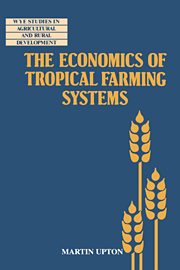Book contents
- Frontmatter
- Contents
- Preface
- Part I Farm household economics
- 1 Farming systems in economic development
- 2 The farmer's environment
- 3 The farmer's production choices
- 4 Labour and leisure
- 5 Costs, scale and size
- 6 Risk avoidance
- Part II Rural resource economics
- Part III Field investigations
- Part IV Farm planning
- Index
1 - Farming systems in economic development
Published online by Cambridge University Press: 05 June 2012
- Frontmatter
- Contents
- Preface
- Part I Farm household economics
- 1 Farming systems in economic development
- 2 The farmer's environment
- 3 The farmer's production choices
- 4 Labour and leisure
- 5 Costs, scale and size
- 6 Risk avoidance
- Part II Rural resource economics
- Part III Field investigations
- Part IV Farm planning
- Index
Summary
The farming population
This book is concerned with the analysis and planning of smallholder farming systems in the developing countries of the tropics and subtropics. Most of the low-income, and lower-middle-income, countries of Africa, Asia and Latin America (with Gross National Product per capita in 1992 of less than US$2,695) lie within these zones. In these countries, general economic development is heavily dependent on the performance of the large agricultural sector, made up mainly of semi-subsistence smallholder family farms.
The aims of this introductory chapter are to demonstrate the importance of the agricultural sector, to outline the domestic and international market environment, within which agricultural producers operate, to review the processes of change in this environment and finally to summarize the major characteristics of the smallholder farming systems.
In terms of the number of people employed, agriculture is the most important single industry in the world. The estimated agricultural population of nearly 2.5 billion, makes up about 44 per cent of the total. Although this proportion is decreasing, as a result of rural–urban migration, the absolute numbers engaged in agriculture are still growing. This pattern is repeated in the developing countries of Africa, Asia (Far East) and Latin America. Agricultural populations are only declining in the upper-middle and high-income countries, where they are already relatively small (see Table 1.1).
- Type
- Chapter
- Information
- The Economics of Tropical Farming Systems , pp. 3 - 23Publisher: Cambridge University PressPrint publication year: 1996

